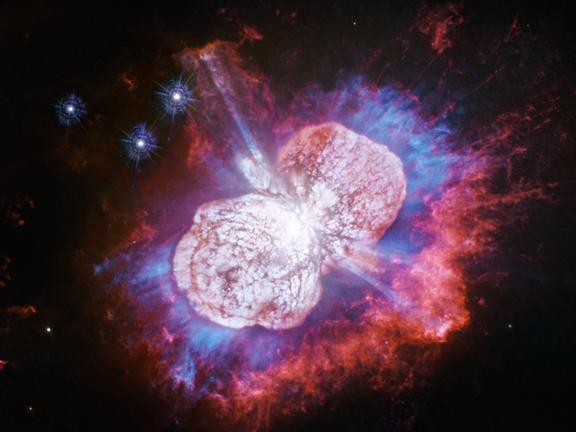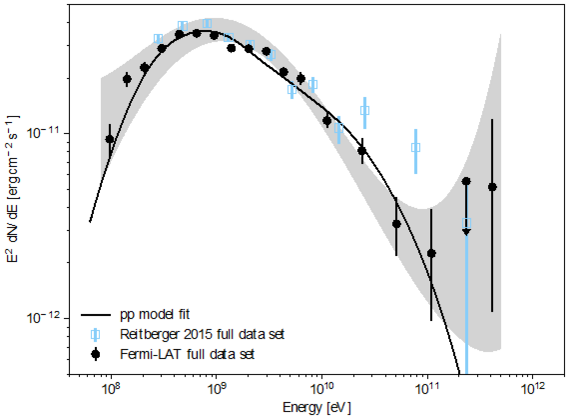Eta Carinae is a bright binary star, located around 7500 light-years distant in the southern constellation Carina. The main star is categorised as a luminous blue variable, and with at least 90 solar masses, it is one of the most massive stars in the Milky Way. Its smaller companion is believed to have a mass in the range of 30 to 50 solar masses and is orbiting around the main star on a highly eccentric elliptic orbit with a period of 5.5 years at a mean distance comparable to that of Uranus from the Sun. Strong stellar winds emerge from both stars and collide with each other – a unique cosmic particle accelerator laboratory.
However, Eta Carinae is not only an astronomical object visible to the naked eye, but also a well-known X-ray and gamma-ray source. However, by which means is this radiation produced and what is the influence of the orbital eccentricity? Now, scientists of the MPIK together with colleagues from DESY have addressed these questions. “We did this by analysing in detail a comprehensive data set of the Fermi gamma-ray satellite, and by refining former model calculations”, explains Richard White, staff scientist in the division of Jim Hinton, and adds: “We paid special attention to the periastron passages, since during these phases of closest approach of the two stars, the X-ray emission shows a pronounced dip after a large rise.”
In contrast, the Fermi-LAT instrument data from 11 years of operation, corresponding to two complete orbits, exhibits intensity variations but no comparable dip of the gamma-ray emission during periastron. “This suggests two different mechanisms are operational for the two energy bands”, concludes PhD student Mischa Breuhaus. Protons experience powerful acceleration in both shocks of the colliding stellar winds. Comparing the model calculations and the data, it is evident that the spectral energy distribution (figure) of the gamma radiation in the range between 80 megaelectron volts and 500 gigaelectron volts can only be explained assuming the gamma rays originate in collisions of accelerated protons with other particles in the winds.
The hard X-ray emission between 30 and 50 kiloelectron volts detected by the X-ray satellite NuSTAR, however, must be produced when accelerated electrons deliver energy to light from the stars (“inverse Compton scattering”). During periastron, the acceleration of electrons is suppressed, and the remaining hard X-rays seem to be emitted by secondary particles produced in the interactions of accelerated protons.
„Due to the heavily variable conditions in the course of an orbit, Eta Carinae represents an excellent model system which could help to better understand the acceleration processes at work in other important systems, including supernova remnants”, Brian Reville, leader of the independent Astrophysical Plasma Theory group, looks into the future.
Another open question is the maximum energy up to which Eta Carinae produces gamma rays. Here H.E.S.S., the gamma-ray observatory in Namibia, comes into play: with its huge telescope it can detect energies down to Fermi’s range. H.E.S.S. detected Eta Carinae during the periastron passage in 2014 [HESS] and is observing again during the present periastron passage. As the telescope was recently upgraded with a novel high-performance camera, the astrophysicists expect exciting results.
Original publication:
Gamma-ray and X-ray constraints on non-thermal processes in Eta Carinae, R. White, M. Breuhaus, R. Konno, S. Ohm, B. Reville, and J.A. Hinton, Astronomy & Astrophysics 635, A144 (2020), https://doi.org/10.1051/0004-6361/201937031
Reference:
[HESS] Detection of very-high-energy gamma-ray emission from the colliding wind binary Eta Car with H.E.S.S., H.E.S.S. Collaboration, Astronomy & Astrophysics 635, A167 (2020), https://doi.org/10.1051/0004-6361/201936761
Independent Group Astrophysical Plasma Theory

